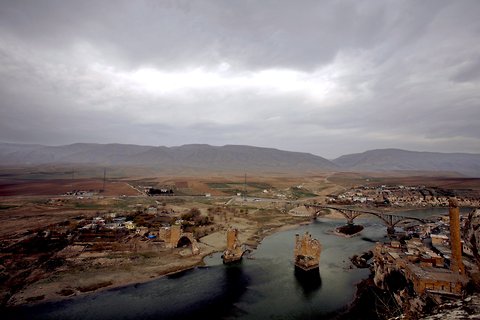February 17, 2012, 7:01 AM
 Tolga Bozoglu/European Pressphoto AgencyHasankeyf, Turkey.
Tolga Bozoglu/European Pressphoto AgencyHasankeyf, Turkey.
Before the Flood
By ANDREW FINKEL Tolga Bozoglu/European Pressphoto AgencyHasankeyf, Turkey.
Tolga Bozoglu/European Pressphoto AgencyHasankeyf, Turkey.HASANKEYF, Turkey — I had been warned before visiting this ancient town by the Tigris River that I was likely to be waylaid by someone named Mehmet, a “hydroelectric stooge.” Hasankeyf, a citadel of sandstone spires, palaces and mosques close to the border with Iraq and Syria, may soon be inundated by the reservoir of the new Ilisu dam. Mehmet and the town’s residents have readily accepted their town’s underwater future.
The Ilisu dam is part of the vast Southeast Anatolian Project (known as GAP, its Turkish acronym), a controversial effort to generate hydroelectric power for the entire national grid. Turkey, which imports much of the energy it consumes and is strapped for foreign currency, needs badly to find some way of meeting its growing demand for power.
Proponents of GAP argue that it is also a development project for the southeastern part of Turkey, the country’s poorest region. They say it will restore the Fertile Crescent to its former glory. Others say it will put the “mess” back into Mesopotamia. I had come to see for myself.
In the event, I saw no Mehmet when I toured the 13th-14th century mosques of Saladin’s descendants in Hasankeyf in October. The only person who sought me out was a charming elderly man who tried in the politest way possible to interest me in his bed and breakfast on the river’s edge. And it was pretty clear that the last thing he wanted was to see his way of life submerged. “We’re not goats. We don’t want to live there,” he told me, pointing to the high rises being built up on the hillside above.
Progress comes at a cost, of course, but for a long time I wondered whether the price of GAP was too high. The issue seemed to boil down to this: Ilisu will provide 3,800 gigawatt hours of electricity per year, or about 2 percent of what the country currently needs. Against that had to be weighed the irreversible damage that would be caused to the unique ecosystem (pdf) and cultural sites of the region — and, of course, the arrogance of expecting people to move from their homes.
Many of the arguments against the project once struck me as a form of vicarious Nimby. Might the pundits and the activists in faraway Istanbul be overlooking the good projects that GAP supports and downplaying their benefits in the name of environmental political correctness?
Some opponents of GAP have also charged that controlling the taps of the Tigris’s headwaters in Turkey would inevitably provoke conflict in the countries downstream. But water rights is perhaps the one topic that hasn’t flared up among these troubled states. And unlike other major dams in GAP, Ilisu is about electricity not irrigation; it regulates, but does not divert, the flow of water to its neighbors.
And then there was the argument that the dam is an instrument to divide and rule Turkey’s Kurdish regions. It seemed overly ingenious. If social control were the object, there would be more efficient ways to spend $1.5 billion.
Now I regret having sat on the fence for so long. What convinced me that the Ilisu dam is a terrible idea is not the splendor I encountered visiting Hasankeyf so much as the new shopping malls and half-constructed apartment skyscrapers lining the highway from the airport in Istanbul that I passed on my way home. They are what is gobbling up the country’s electricity and what will destroy the Tigris River basin. Most of Ilisu’s electricity will flow west, far from where it is generated.
Better to spend the hundreds of millions of dollars the dam will have cost, I now realize, on reducing waste in the national electricity grid. This runs at up to 18 percent, according to Izak Atiyas, an economist at Sabanci University, and he says it could be cut by half.
Turkish activists have tried for some years to have Hasankeyf added to Unesco’s World Heritage list, but this would require a government signature that has not been forthcoming. It may be too late to stop the flood. Up to 600 sites are threatened by the Ilisu dam, including Gre Amer, where evidence of Neolithic civilizations are coded in chips of rock and bits of clay — adobe secrets that will soon revert to mud.
Andrew Finkel has been a foreign correspondent in Istanbul for over 20 years, as well as a columnist for Turkish-language newspapers. His latest book, “Turkey: What Everyone Needs to Kn


Leave a Reply